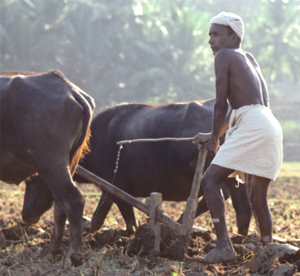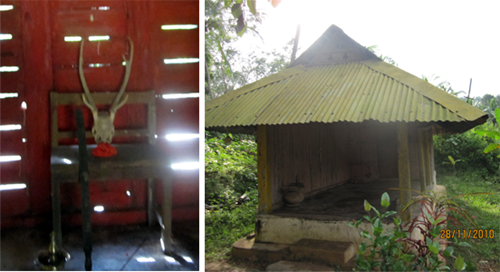Dec 21, 2025
Dec 21, 2025
The efficient and satisfactory collaboration of the athletes in a relay run in carrying the baton from start to finish is always a telling figure of speech. The central group that carries the baton to a certain point, hands over the same to a peripheral group that becomes, for a time, central. A relay race staged between different language communities of successive agriculturists is one wherein they passed on the knowledge of the plough as a relay baton. In the relay race, the last may come first, and the first last. The geographical zigzag of terms related as a result has made the term nangol a word puzzle. An attempt is made here to find which language did pioneer the rally.
 The Malayalam word for plough, ploughshare/ shaft is nennol. Its variants in Malayalam are nennal/ nennil, nennel, nennilu, nennelu. The other Dravidian languages picked up this word as follows: nennal, nennol, nennil, nennel, nenci, nenne(lu), nene(lu) inside Nanchinadu; and nancil (Tamil); negel, negil, negala (Kannada); nelg (Kota); nengil, nengi (Kudagu); nayar, nair (Tulu); nagali, nagelu, nagelu (Telugu); nangel (Gondi); nangel, (Kuwi); nangelli (Kuwi); nangar (Naiki); naghgli, nagheli, nangar (Naiki); nagil (Parsi); nangal (Gadaba); nangala (Pali) outside Nanchinadu. These words, representing the regional variations of the word, show the linguistic area covered by the word nennol on its onward march from/ outside Nanchinadu. Plough is called nangal in Bengal and langala in Sanskrit.
The Malayalam word for plough, ploughshare/ shaft is nennol. Its variants in Malayalam are nennal/ nennil, nennel, nennilu, nennelu. The other Dravidian languages picked up this word as follows: nennal, nennol, nennil, nennel, nenci, nenne(lu), nene(lu) inside Nanchinadu; and nancil (Tamil); negel, negil, negala (Kannada); nelg (Kota); nengil, nengi (Kudagu); nayar, nair (Tulu); nagali, nagelu, nagelu (Telugu); nangel (Gondi); nangel, (Kuwi); nangelli (Kuwi); nangar (Naiki); naghgli, nagheli, nangar (Naiki); nagil (Parsi); nangal (Gadaba); nangala (Pali) outside Nanchinadu. These words, representing the regional variations of the word, show the linguistic area covered by the word nennol on its onward march from/ outside Nanchinadu. Plough is called nangal in Bengal and langala in Sanskrit.
The relay of the baton continued even beyond the boundaries of Indian languages. In the languages of Mon-Khmer and Indonesian, the plough is designated by the following terms: Khmer ankal; Cam -lanan, lanal, lanar; Khasi ka-lynkor; Tembi tengala; Malay tengala, tangala; Batak tingala; Makassar nankala. Levi and others explain that these different forms show that they were either borrowed “from Indo-Aryan (cf. Sanskrit langalam) or that they are all derived from an ancient Austro-Asiatic word, of which the beginning and the end might have undergone several modifications while the middle part remained more stable.” In Munda, there is Santali nahel for plough. It is interesting because no one knows who have borrowed from whom. Burrow says that Dravidian has borrowed independently from the same source: Ta. nancil, Ka negal, etc. “A non-prefixed form with the change k>h characteristic of the northern group of Munda languages, appears in Sanskrit as hala- ‘plough.’
The Harappans used a plough, and the Rg Vedic word for 'plough', langala, is probably derived from proto-Dravidian nangal. Examples are there, of the replacement of Proto-Dravidian n- with l- in Indo- Aryan, even if the etymon may ultimately go back to Austro-Asiatic.
Nangol: A cross-word puzzle
Aphaeresis can be defined as the loss or omission of one or more segments from the beginning of a word. Aphesis, a technical term in linguistics for a form of elision, refers to the loss of letters at the beginning of a word. It is the common loss of short unaccented first vowels at the beginning of a word as the result of a phonetic process; as, squire for esquire.
Sounds may be unintentionally elided for euphonic effect. For example, over becomes o’er. The dropping of one or more sounds (such as a vowel, a consonant, or a whole syllable) in a word or phrase is elision. Sometimes it may be deliberate, to enable the speaker to pronounce it easily. In Malayalam language, dropping of sounds or words in spoken or written discourse is very common. To cite two examples the words ‘entha’ and ‘ippol’ becomes ‘ntha’ and ‘ippo’ respectively.
Here, the comment of Gundert, that ‘ma’ is often pronounced where ‘va’ is original, is relevant. Vannam in the word atinmannam becomes nmannam; vina becomes mina. The words masuri, mizunnuka become vasuri, and vizunnuka respectively. In other dialects, initial ‘ma’ is represented by na in the words like mayir, mayil, mozhi etc. Peacock is mayil in Tamil and Malayalam. It is njamali in Canarese, and namali in Telugu. Mayir for hair in Tamil and Malayalam is navir in Canarese. A promise is mozi in Malayalam. In Canarese, it is nudi.
Nja of Malayalam represents na or ya of the other Dravidian languages. Na is related with na as in naam from njan, and ya (nukam /yugam, (aakina = aakiya). A noun changes dialectally with ma (nuppatu, nunpe, mayil). The ancient Malayalam word nuppathu means muppathu. The literate people, spelt the words such as mooppar, munpey etc as nooppar, numpey respectively even on these days.
In the light of Gundert’s finding, the words for plough nangol begin with initial na or nja. We saw the word for peacock mayil becoming njamali in Canarese, and namali in Telugu. This shows that the original word for nangol must start with ma as initial. This philological rule helped the word nangol retrieve its original initial ma. With the initial ma gained, the word will read maankol. The same rule can be applied to nukam/ nokam, pointing out its original word as makam. Baiga, a tribe found in Madhya Pradesh, Uttar Pradesh, Chhattisgarh and Jharkhand states of India, called a group of five stars, as the nangar (plough). The tenth constellation, magha is in the shape of a plough and as such is called makam/nennol. Also called muzhakkol, this constellation rising in Dhanu (in the sign of Saggitarius), an hour after sunset, indicates the time for treading the wheel previous to sowing. The word kalappaichakram in Tamil, denotes, a diagram in astrology in the form of a plough to determine the best day for beginning the ploughing of the season.
Nangol: An Antique Word
A long tube to shoot birds or fishes with clay pellets, arrows, etc. is nachukkol. Mlankol made of the shank of an elk is used to extract toddy from the coconut tree. Like that, when the antler came to be used to plough, it came to be known as maankol.
While nachukkol is made out of a tube, mlankol and maankol are shank of an elk and an antler respectively. This indicates the remoteness of the instrument. But how the word maankol subsequently became nangol, nancil (Tamil), nennil (Mal.), nagil (Te), negil (C), nayar/ nair (Tu) is part of linguistic history.
Traditional Houses of Travancore
Asko Parpola, who deciphered the script of the Indus valley civilization, cited as example, a few a Dravidian loan words in the Rg Veda, such as phalam, mukham, khala and nangol. All these words are spoken in south Travancore.
“Loanwords from Dravidian have been identified from Indo-Aryan texts composed in northwestern India around 1100-600 BCE. These six examples are from the earliest text, the Rigveda (the capital letters are retroflex consonants, which did not exist in Proto-Indo-Iranian): mukham ‘face, front, mouth’ < PD *mukam ‘id;’ khalam ‘threshing floor’ < PD *kaLam ‘id;’ phalam ‘fruit’ < PD *paZam ‘ripe fruit;’ kuNDam ‘pit;’ < PD *kuNTam ‘pit;’ kaaNa- ‘blind in one eye’ < PD *kaaNa ‘not seeing;’ kiyaambu- ‘watery plant’ < PD *kiyampu ‘taro, aroid, Colocasia.’
Fruit as well as crop is phalam. The front structure of the house, the portico, is called poomukham. From a beautifully carved-out outcrop called thattupati, the kaaranavar of the house managed the affairs of the house as well as the sprawling field, lying in front of the house, in the easterly direction, within range of eye-shot. Malanaattil makamethi kalamellam methi nirthi, is a popular Malayalam rhyme which means Makam arrived in Kerala; treading out grains stopped in all the threshing areas.” The kalam mentioned in this rhyme is the kalakkottil/ kalappura, the ground levelled for threshing and for spreading grains etc., for drying. Lying in the southwest, at the feet of Vastu Purush, with Nirti (Lord of Demons) as the ruling God, this farmhouse has a barn. During harvest, this farmhouse used to reverberate with kalappaattu, the song or ballad of the threshing floor. Bhadrakali is the presiding deity of the kalam. Kuntam (pit), kaana (imperceptible, one-eyed) are yet other words Parpola spoke of as having been borrowed by Sanskrit from Dravidian language. If the meaning of the kuntam is taken as a pond, invariably almost houses of this type had a pond for bathing purposes in front of the house in the east northerly direction.
The fact that by the time the Aryans entered India around the middle of the second millennium BC., the Dravidians were located in northwestern India is almost confirmed. Rgvedic Sanskrit, the earliest form of Sanskrit known (c.1500 BC), already had over a dozen local items borrowed from Dravidian, eg. ulookhalam, a wooden mortar, is a loanword in Sanskrit. A mortar made of wood or stone or wood, for pounding or polishing grains is ural. These houses had them kept at ura(l)kkalam a mortar-shed, also called nellukuthupura/ ura(l)ppura-. In this shed, paddy was husked as well as pounded.

The Malayalam words kari(vi), karu(vi) are known to mean plough. Are they not related to the antelope called kari, karu, kari(nchara)man? A structure found on the southern side of the ancient Kerala houses, are called thekkathu. These shrines were dedicated to manes or family deities, who were invoked to inhabit in them. Antler worship practised from time immemorial in these shrines attached to the traditional houses of south Travancore, bears testimony to the belief that antlers were used as the original plough, which was subsequently replaced by wooden plough. The matriarchic system followed in these houses was only an adoption of the same system followed by the deer community. The location of these houses, found in the immediate vicinity of paddy fields, fed by rain, was perhaps the original shelter of the antelope. In these fields, where dry culture was practised, paddy was cultivated during the south-east monsoon and harvested on September. In these houses, the birth of rice was celebrated on the makam asterism, in the month of kanni (Aug-Sept.). Perhaps before the advent of river valley civilization, single crop cultivation was practised in these rain-fed paddy fields.
Invariably 99% of these types of houses are oriented towards the east with facilities to monitor agriculture based activities from the portico of the house. Built vasthu-wise, all these houses present the same look and the name of the living space bears the same appellation in all places. The difference in the utility of the living space for male as well as female members of the house is uniformly the same, wherever it may be. Rituals round the year practised in these houses made them unique in the world. Like Gundert’s philological rule that enabled to fix the language in which the word nangol was first spoken, his citing nair as a Tulu word, holds the key to the origin of the word Nair. Perhaps these houses moulded the Nair caste, originated from nangol.
01-Jan-2011
More by : Dr. V. Sankaran Nair

|
VERI GUID (sic): Rendering of an Ancient Series of Cross cultural Flows relating to The growing of Food ... My belief is that Beyond the Weather [words] Sun, Rain ,Storms ,Grain I believe Fish Words were the Catalyst in moving People around...you Comment on First and last Rondo's This is a great viewpoint! Why Fish ? I think with Diasporas in Peoples movement from the Shores inland and not the Other way around although Rainforest folk could do both as they had Rivers I subscribe to NanGol T* |